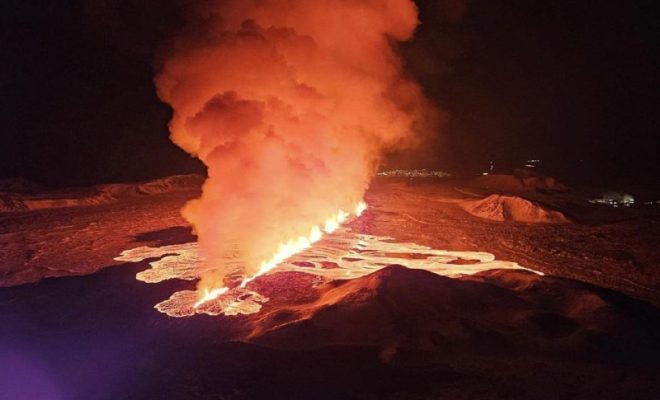Iceland’s Volcanic Eruption Losing Steam, Defenses Holding Strong

Iceland’s latest volcanic eruption, which began on July 10th near the Meradalir valley, has been captivating viewers worldwide with its fiery display of nature’s raw power. However, recent reports from the Icelandic Meteorological Office (IMO) suggest that the intensity of the eruption is decreasing, and the defensive measures put in place are effectively containing the lava flow, much to the relief of local communities.
Diminishing Volcanic Activity
The once-towering lava fountains that had been spewing molten rock high into the air have now dwindled to a mere trickle. According to the IMO’s observations, the eruption’s output has significantly reduced over the past few days, with the lava flow rate dropping from a staggering 10 cubic meters per second to just 3 cubic meters per second.
This decrease in volcanic activity is a promising sign that the eruption may be entering a less intense phase, potentially signalling an eventual end to the fiery spectacle. However, experts caution that volcanic systems are complex and can be unpredictable, making it essential to maintain vigilance and continue monitoring efforts.
Protective Barriers Withstand Nature’s Fury
In anticipation of the potential threat posed by the eruption, Icelandic authorities swiftly constructed extensive barriers to divert the lava flow away from nearby infrastructure and residential areas. These defensive measures, comprising earthen berms and high-tech water-cooling systems, have proven remarkably effective in protecting the surrounding regions from the molten rock’s destructive path.
The success of these barriers is a testament to Iceland’s preparedness and commitment to safeguarding its communities in the face of natural disasters. The nation’s ability to adapt and respond swiftly has minimized the impact of the eruption on daily life, allowing residents to carry on with their activities while nature’s spectacle unfolds in the distance.
A Spectacle for Scientists and Tourists
Despite the waning volcanic activity, the eruption site continues to draw crowds of scientists and curious onlookers, eager to witness and study this rare and awe-inspiring natural phenomenon. Researchers have seized this opportunity to gather valuable data, enhancing our understanding of volcanic processes and helping to improve future preparedness efforts.
Meanwhile, tourists from around the world have flocked to the area, mesmerized by the chance to witness the mesmerizing display of nature’s might up close. Local authorities have implemented strict safety measures, ensuring that visitors can experience the spectacle while remaining at a safe distance from potential hazards.
Also Read | Joe Biden reveals $7.3 trillion budget as part of campaign strategy
Monitoring Continues as Uncertainty Lingers
While the current trend suggests a potential end to the eruption shortly, experts from the IMO and other agencies caution that volcanic activity can be unpredictable, and complacency should be avoided. Round-the-clock monitoring efforts will continue, with teams of scientists and emergency personnel prepared to respond swiftly if the situation changes or intensifies unexpectedly.
As the eruption enters a potentially quieter phase, Iceland’s resilience and preparedness have once again been put to the test. The nation’s ability to adapt and safeguard its communities in the face of nature’s might serves as a testament to its unwavering spirit and commitment to public safety, ensuring that even the most awe-inspiring natural events can be managed with minimal disruption to daily life



